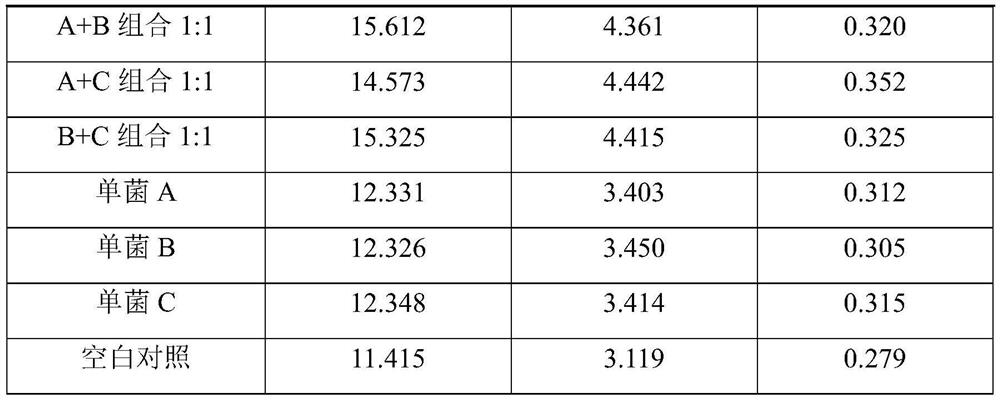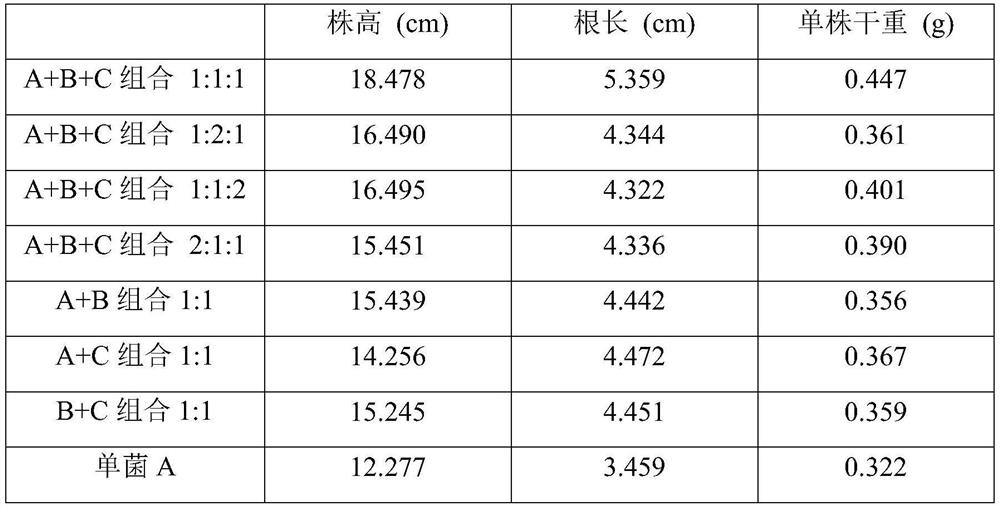A mixed flora of microorganisms that promote plant growth
A technology for promoting plant growth and mixing flora, applied in plant growth regulators, plant growth regulators, microorganisms, etc., can solve problems such as affecting the quality of surface water and groundwater, reducing the quality of agricultural products, and increasing planting costs.
- Summary
- Abstract
- Description
- Claims
- Application Information
AI Technical Summary
Problems solved by technology
Method used
Image
Examples
Embodiment 1
[0017] Microbial mixed flora promotes growth of hydroponic plants
[0018] The specific implementation steps are as follows:
[0019] Flavobacterium pectinovorum CGMCC12362 (denoted as bacteria A), Lysobacter ruishenii CGMCC10136 (denoted as bacteria B), Enterobacter mori CGMCC10322 (denoted as bacteria C), were inoculated separately Into LB medium, cultured with shaking at 30°C until the bacterial concentration is O.D. 600 ≈2.0, mixed according to the volume ratio of 1:1:1, 1:2:1, 1:1:2, 2:1:1 respectively, and at the same time, two kinds of bacteria were selected and mixed in the volume ratio of 1:1, and then Take the single-bacteria culture solution of three kinds of bacteria. Each of the above-mentioned culture solutions was prepared according to the 10 6 The final microbial concentration of CFU / ml was added to the rhizosphere of rapeseed in the hydroponic system, and the culture was continued for 1 week. In the present invention, a blank control group is also set, and...
Embodiment 2
[0025] Microbial mixed flora promotes soil culture plant growth
[0026] The specific implementation steps are as follows:
[0027] Flavobacterium pectinovorum CGMCC12362 (denoted as bacteria A), Lysobacter ruishenii CGMCC10136 (denoted as bacteria B), Enterobacter mori CGMCC10322 (denoted as bacteria C), were inoculated separately Into LB medium, cultured with shaking at 30°C until the bacterial concentration is O.D. 600 ≈2.0, mixed according to the volume ratio of 1:1:1, 1:2:1, 1:1:2, 2:1:1 respectively, and at the same time, two kinds of bacteria were selected and mixed in the volume ratio of 1:1, and then Take the single-bacteria culture solution of three kinds of bacteria. Each of the above-mentioned culture solutions was prepared according to the 10 6 The final microbial concentration of CFU / ml was added to the rhizosphere of rapeseed in the soil culture system, and the culture was continued for 1 week. Under the same conditions, an equal amount of water was added to...
Embodiment 3
[0033] Determination of Auxin Secreting Ability of Microbial Strains
[0034] The specific implementation steps are as follows:
[0035] Flavobacterium pectinovorum CGMCC12362 (denoted as bacteria A), Lysobacter ruishenii CGMCC10136 (denoted as bacteria B), Enterobacter mori CGMCC10322 (denoted as bacteria C), were inoculated separately Into LB medium, cultured with shaking at 30°C until the bacterial concentration is O.D. 600 ≈2.0. Take 100 mL of the three bacterial cultures respectively, and use high-performance liquid chromatography-tandem mass spectrometry to measure the auxin (IAA) content therein, as shown in Table 3 below.
[0036] Table 3 Results of strain secretion auxin experiment
[0037] Growth hormone secretion capacity (mg / L) Bacteria A 306.5 Bacteria B 356.1 Bacteria C 328.2
[0038] It can be known from Example 3 that all three strains have the ability to secrete auxin, which can promote plant growth and increase crop yield ...
PUM
 Login to View More
Login to View More Abstract
Description
Claims
Application Information
 Login to View More
Login to View More - R&D
- Intellectual Property
- Life Sciences
- Materials
- Tech Scout
- Unparalleled Data Quality
- Higher Quality Content
- 60% Fewer Hallucinations
Browse by: Latest US Patents, China's latest patents, Technical Efficacy Thesaurus, Application Domain, Technology Topic, Popular Technical Reports.
© 2025 PatSnap. All rights reserved.Legal|Privacy policy|Modern Slavery Act Transparency Statement|Sitemap|About US| Contact US: help@patsnap.com



